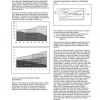Free Online Productivity Tools
i2Speak
i2Symbol
i2OCR
iTex2Img
iWeb2Print
iWeb2Shot
i2Type
iPdf2Split
iPdf2Merge
i2Bopomofo
i2Arabic
i2Style
i2Image
i2PDF
iLatex2Rtf
Sci2ools
DAC
1996
ACM
1996
ACM
RTL Emulation: The Next Leap in System Verification
ion. Production use of text-based methodology has enabled designers to capture designs of hundreds of thousands of gates using graphic ESDA tools. Source: Data Quest (Verilog/VHDL Market SpecialReport) Second, is the change in manufacturing process. Today, designers are using 0.35 micron or even 0.25 micron technology. Submicron manufacturing capabilities enable millions of gates on a single chip. Sematech predicts that 0.25 micron technology will be ubiquitous by 1998 and the average chip complexity will be 20 million transistors. With most ASIC fabs running 0.5 micron processes reliably, and several delivering or scheduling a move to 0.25 micron soon, manufacturing capabilities are quickly outgrowing the capacity of current design tools. The obstacles in developing new generation of electronics revolve around three key questions:
| Added | 08 Aug 2010 |
| Updated | 08 Aug 2010 |
| Type | Conference |
| Year | 1996 |
| Where | DAC |
| Authors | Sanjay Sawant, Paul Giordano |
Comments (0)

